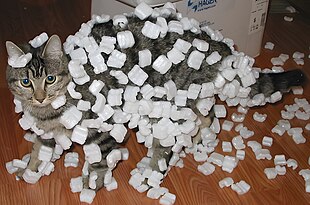
Back كهرباء الاحتكاك Arabic Трыбаэлектрычнасць Byelorussian Efecte triboelèctric Catalan Triboelektrický jev Czech Reibungselektrizität German Triboelektro Esperanto Efecto triboeléctrico Spanish Hõõrdeelekter Estonian اثر برق مالشی Persian Hankaussähkö Finnish

| Articles about |
| Electromagnetism |
|---|
 |
The triboelectric effect (also known as triboelectricity, triboelectric charging, triboelectrification, or tribocharging) describes electric charge transfer between two objects when they contact or slide against each other. It can occur with different materials, such as the sole of a shoe on a carpet, or between two pieces of the same material. It is ubiquitous, and occurs with differing amounts of charge transfer (tribocharge) for all solid materials. There is evidence that tribocharging can occur between combinations of solids, liquids and gases, for instance liquid flowing in a solid tube or an aircraft flying through air.
Often static electricity is a consequence of the triboelectric effect when the charge stays on one or both of the objects and is not conducted away. The term triboelectricity has been used to refer to the field of study or the general phenomenon of the triboelectric effect,[1][2][3][4] or to the static electricity that results from it.[5][6] When there is no sliding, tribocharging is sometimes called contact electrification, and any static electricity generated is sometimes called contact electricity. The terms are often used interchangeably, and may be confused.
Triboelectric charge plays a major role in industries such as packaging of pharmaceutical powders,[3][7] and in many processes such as dust storms[8] and planetary formation.[9] It can also increase friction and adhesion. While many aspects of the triboelectric effect are now understood and extensively documented, significant disagreements remain in the current literature about the underlying details.
- ^ Cite error: The named reference
:19was invoked but never defined (see the help page). - ^ Cite error: The named reference
:34was invoked but never defined (see the help page). - ^ a b Watanabe, H.; Ghadiri, M; Matsuyama, T.; Diing, Y.; Pitt, K.; Maruyama, H.; Matsusaka, S.; Masuda, H. (2007). "Triboelectrification of pharmaceutical powders by particle impact". International Journal of Pharmaceutics. 334 (1–2): 149–155. doi:10.1016/j.ijpharm.2006.11.005. hdl:2433/194296. ISSN 0378-5173. PMID 17141989.
- ^ Cite error: The named reference
:28was invoked but never defined (see the help page). - ^ "Triboelectricity". Education.MRSEC.Wisc.edu. Materials Research Science and Engineering Centers Education Group / University of Wisconsin–Madison. 2020. Retrieved 21 July 2023.
- ^ "Collins English Dictionary". 23 July 2023. Retrieved 23 July 2023.
- ^ Wong, Jennifer; Kwok, Philip Chi Lip; Chan, Hak-Kim (2015). "Electrostatics in pharmaceutical solids". Chemical Engineering Science. 125: 225–237. Bibcode:2015ChEnS.125..225W. doi:10.1016/j.ces.2014.05.037.
- ^ Kok, Jasper F.; Renno, Nilton O. (2008). "Electrostatics in Wind-Blown Sand". Physical Review Letters. 100 (1): 014501. arXiv:0711.1341. Bibcode:2008PhRvL.100a4501K. doi:10.1103/physrevlett.100.014501. ISSN 0031-9007. PMID 18232774. S2CID 9072006.
- ^ Blum, Jürgen; Wurm, Gerhard (2008). "The Growth Mechanisms of Macroscopic Bodies in Protoplanetary Disks". Annual Review of Astronomy and Astrophysics. 46 (1): 21–56. Bibcode:2008ARA&A..46...21B. doi:10.1146/annurev.astro.46.060407.145152. ISSN 0066-4146.
© MMXXIII Rich X Search. We shall prevail. All rights reserved. Rich X Search